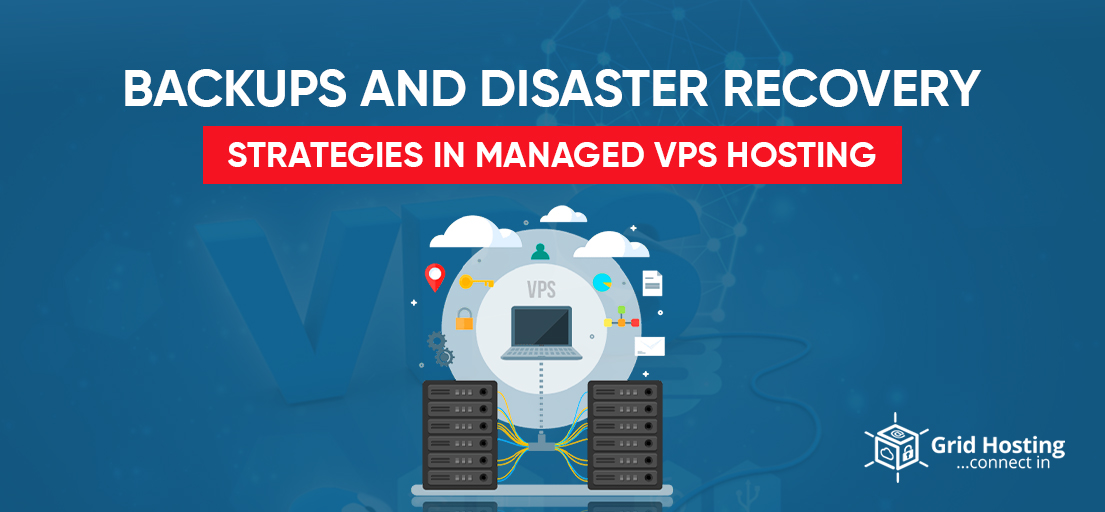Every website, commercial or personal, is built on vast amounts of data. Its demise would be catastrophic. Other possibilities that can result in data loss include, to name a few, corruption, unintended deletion, and hacker attacks. Fortunately, there is a technique to protect oneself from such problems regular data backups.
Knowing the finest backup and disaster recovery practices can provide you and your website visitors with the assurance that all data is safe and secure. Backups and disaster recovery solutions come into play here. In this article, we will look at backups and disaster recovery in the context of managed VPS hosting.
What is Managed VPS Hosting
Managed VPS Hosting is a managed solution that eliminates the need for you to bother about server management. Your service provider handles server maintenance such as core upgrades, software installation, backup, security, and more with Managed VPS Hosting. As a result, instead of worrying about server management, you can spend your time and energy on growing your business. Because it streamlines your job, Managed VPS Hosting may be chosen by any business owner, regardless of technical experience.
Importance of Backups and Disaster Recovery
In the realm of information technology and corporate operations, backups and disaster recovery are critical. They safeguard sensitive data by assuring its survival in the face of hardware failures, human error, or cyber threats. Disaster recovery plans, on the other hand, are critical in minimizing downtime during unexpected events like natural disasters or cyberattacks, allowing firms to continue operations while following legal and regulatory requirements. These protections are meant to protect not only an organization’s reputation and integrity but also to reduce risk.
They can save money by preventing data loss, downtime, and legal problems. Backups and disaster recovery provide assurance and peace of mind that data is secure and business continuity is ensured in a fast-expanding digital ecosystem.
Backups
Backups are critical to data security. To back up your data, you can utilize external hard drives, online storage, or backup software. The transfer of physical or virtual files or databases to a secondary place for preservation in the case of equipment failure or disaster is referred to as backup. Backing up data is critical to a good disaster recovery plan.
Types of Backups
You can use numerous sorts of backups to secure your data.
Full Backup: The most fundamental and thorough backup method, in which all data is transferred to another place.
Incremental Backup: Backs up all files that have changed since the previous backup.
Differential Backup: Backs up just modified versions of all files since the last full backup.
Disaster Recovery Strategies
Disaster recovery strategies are essential for businesses and organizations to ensure continuity in the face of unforeseen events. Here are some common disaster recovery strategies.
-
Risk Evaluation
The first stage in developing a disaster recovery strategy is to identify and assess potential hazards and repercussions to your company. Consider the probability and severity of various eventualities, such as data loss, system failure, network outage, or physical damage. You should also evaluate the importance and dependency of your company’s procedures, assets, and resources. This will assist you in prioritizing and allocating recovery resources.
-
Recovery Objective
The following phase in developing a disaster recovery strategy is to set your recovery objectives, which are the goals and benchmarks for resuming business activities. These objectives are commonly known as the Recovery Point Objective (RPO), Recovery Time Objective (RTO), and Recovery Level Objective (RLO). Setting reasonable and achievable recovery objectives based on your risk assessment, company needs, and stakeholder expectations is critical. This ensures that your business continuity is not jeopardized and that you can resume operations in a reasonable amount of time with a good level of service or performance.
-
Recovery Strategies
The third phase in developing and implementing a disaster recovery strategy is to develop and implement recovery strategies, which are the activities and solutions to reach your recovery objectives. Data backup and restoration, system and network redundancy, alternate site and equipment, communication and coordination, and roles and duties should all be included in your strategies. To ensure their effectiveness and efficiency, these methods must be tested and updated on a regular basis.
-
Business Continuity
This step in a disaster recovery strategy ensures business continuity, or the capacity to sustain and resume critical company functions during and after a disruptive incident. To do this, conduct a business impact study, develop a business continuity plan, and put in place a business continuity management system. Aligning your business continuity and disaster recovery strategies, as well as embedding them into your broader business resilience framework, will help you ensure that your organization is ready for any disruptive event.
-
Learning Experiences
The final phase in developing a disaster recovery strategy is to learn from your mistakes and improve your procedures. You should undertake a post-incident evaluation and analysis to identify and address your disaster recovery strategy’s strengths, shortcomings, opportunities, and dangers. To improve your knowledge and skills, you should also collect and incorporate input from your stakeholders and experts. Based on your lessons learned and best practices, you should update and adapt your disaster recovery strategy and procedures.
Testing and Maintenance
Testing and maintenance are critical components of a robust disaster recovery plan. Regularly validating and updating your disaster recovery strategies is essential to ensure they are effective when needed. Here are some key points related to testing and maintenance.
Testing
Scheduled Testing: Regularly schedule and conduct testing of your disaster recovery plan. The frequency of testing will depend on your organization’s needs but should typically occur at least annually.
Types of Testing
Full-scale Testing: Simulate a complete disaster recovery scenario to ensure all aspects of the plan work as expected.
Partial Testing: Focus on specific components or systems to test their recovery procedures.
Tabletop Exercises: Conduct discussions and walkthroughs of the disaster recovery plan with key personnel to identify gaps and improvements.
Testing Objectives
- Ensure data and applications can be recovered within acceptable timeframes.
- Verify that communication and notification processes are effective.
- Assess the performance of staff in executing recovery procedures.
- Evaluate the accuracy of documentation and contact information.
- Keep records of test results, including any issues or challenges encountered during testing. Use this information to refine the disaster recovery plan.
Maintenance
Regular Updates: Update your disaster recovery plan on a regular basis to reflect changes in your IT infrastructure, business processes, and staff. This should be a continuous process.
Technology Updates: Keep hardware, software, and firmware up to date to ensure compatibility with your recovery strategies.
Risk Assessment: Review the risk landscape on a regular basis to identify new threats and vulnerabilities that may demand changes to your plan.
Employee Training: Keep an ongoing training programme in place to ensure that personnel understands their duties and responsibilities in the case of a disaster.
Vendor Relationships: Examine and refresh your relationships with disaster recovery service providers, cloud suppliers, and other third-party vendors to ensure they are in sync with your requirements.
Regulatory Compliance: Ensure that your disaster recovery plan remains compliant with industry regulations and standards. Make updates as needed to maintain compliance.
Security Considerations
Security considerations are paramount in any disaster recovery plan to protect sensitive data, applications, and systems during and after a disaster. Here are key security considerations to include:
Access Control: Implement strict access control measures to limit who can make changes to the disaster recovery plan and who can access critical systems and data during recovery.
Network Security: To protect your infrastructure during recovery, maintain strong network security measures such as firewalls, intrusion detection systems, and intrusion prevention systems.
Authentication: To ensure that only authorized persons may access recovery systems, use robust authentication mechanisms such as multi-factor authentication (MFA).
Security Patch Management: Keep all software and firmware up to date with security patches to mitigate vulnerabilities that could be exploited during a disaster.
Secure Backup Storage: Ensure that backups are stored securely, both onsite and offsite, to prevent unauthorized access to critical data.
Compliance and Legal Requirements
Compliance and legal requirements play a significant role in shaping an organization’s disaster recovery plan. Ensuring that your plan aligns with applicable regulations is crucial to avoid legal issues and financial penalties. Here are some key aspects to consider:
Identify Relevant Regulations: Determine which laws, regulations, and industry-specific standards apply to your organization. Common examples include GDPR, HIPAA, SOX, and PCI DSS.
Data Protection: Ensure that sensitive and personal data is protected during disaster recovery. Encryption, access controls, and data classification are essential.
Data Retention and Disposal: Comply with regulations regarding data retention and secure data disposal. Develop policies for preserving and purging data appropriately.
Audit and Documentation: Maintain detailed records of your disaster recovery processes, testing, and compliance measures. Be prepared to provide documentation in case of an audit.
Privacy Regulations: Organizations handling personal data, like GDPR and CCPA, have a plan for handling data subject access requests (DSARs) and data breaches during recovery.
Financial Regulations: Comply with financial regulations, such as SOX (Sarbanes-Oxley Act), which includes requirements for financial data protection and retention.
Third-Party Vendors: Ensure that any third-party vendors or cloud service providers you use for disaster recovery also meet compliance standards and provide the necessary assurances.
You May Also Like to Read: Why Is VPS Hosting UK The Best Option For Your Blog Website?
Altogether
Managed VPS hosting offers several indisputable benefits, like segregated accounts, customized resources, and speedier performance. The team of professionals who look after your server is the most important of all, especially when it comes to data backups and general security. They perform off-site backups, monitor your resource usage, and do a variety of other tasks. However, as a user, you must understand the mechanisms underlying disaster recovery techniques and backup plans. As a result, you’ll be able to actively safeguard your website from the potentially disastrous repercussions of data loss and system outage.
Grid Hosting Complete Managed Backup Services Will Protect Your Company’s Data in the Event of a Disaster
For enterprises and business owners, our data backup experts can make the procedure simple, easy, and completely hands-off. The finest aspect of Grid Hosting’s cloud backup services is the freedom we offer when collaborating with other cloud backup services. We can assist you in determining the appropriate backup solutions and cloud backups to meet your present needs as well as forecasting future wants.
How does Grid Hosting’s managed cloud backup for business vary from other firms’ cloud backup services? Grid Hosting provides more than just cloud backup. For example, we offer a free one-hour consultation to help you create a solid disaster recovery plan, as well as a free backup service installation. Experts are ready to help you if you have questions or want to learn how to get started with backup services.
For Special discounts and offers, visit our official Facebook Page







